Managing Quality in Health and Social Care: Perspectives, Standards, and Implementation Approaches
VerifiedAdded on 2023/01/11
|14
|4875
|74
AI Summary
This research paper focuses on managing quality in health and social care, including perspectives of stakeholders, role of external agencies in setting standards, impact of poor service quality, existing standards for measuring quality, and different approaches to implementing quality systems. It also explores strategies for achieving quality in health and social care services.
Contribute Materials
Your contribution can guide someone’s learning journey. Share your
documents today.
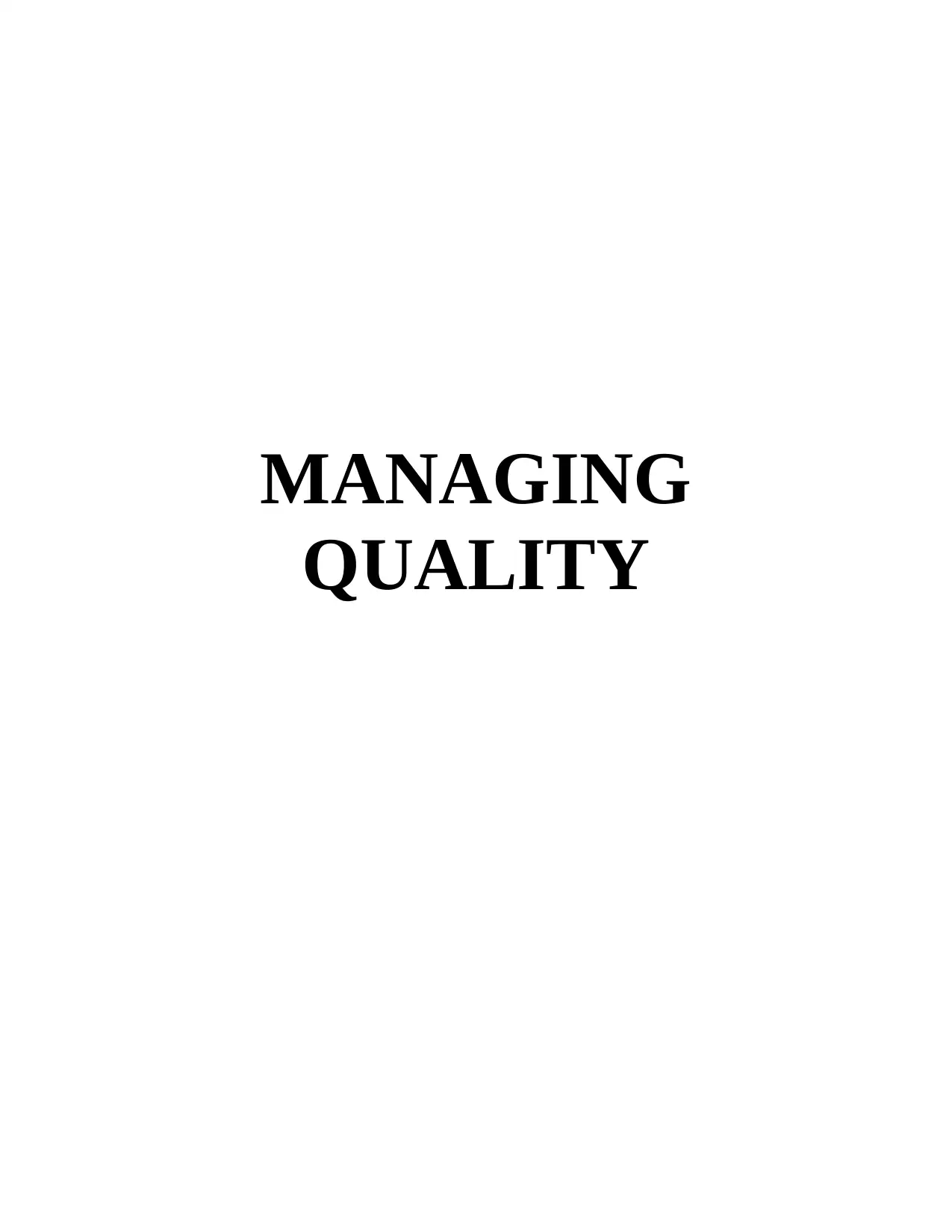
MANAGING
QUALITY
QUALITY
Secure Best Marks with AI Grader
Need help grading? Try our AI Grader for instant feedback on your assignments.
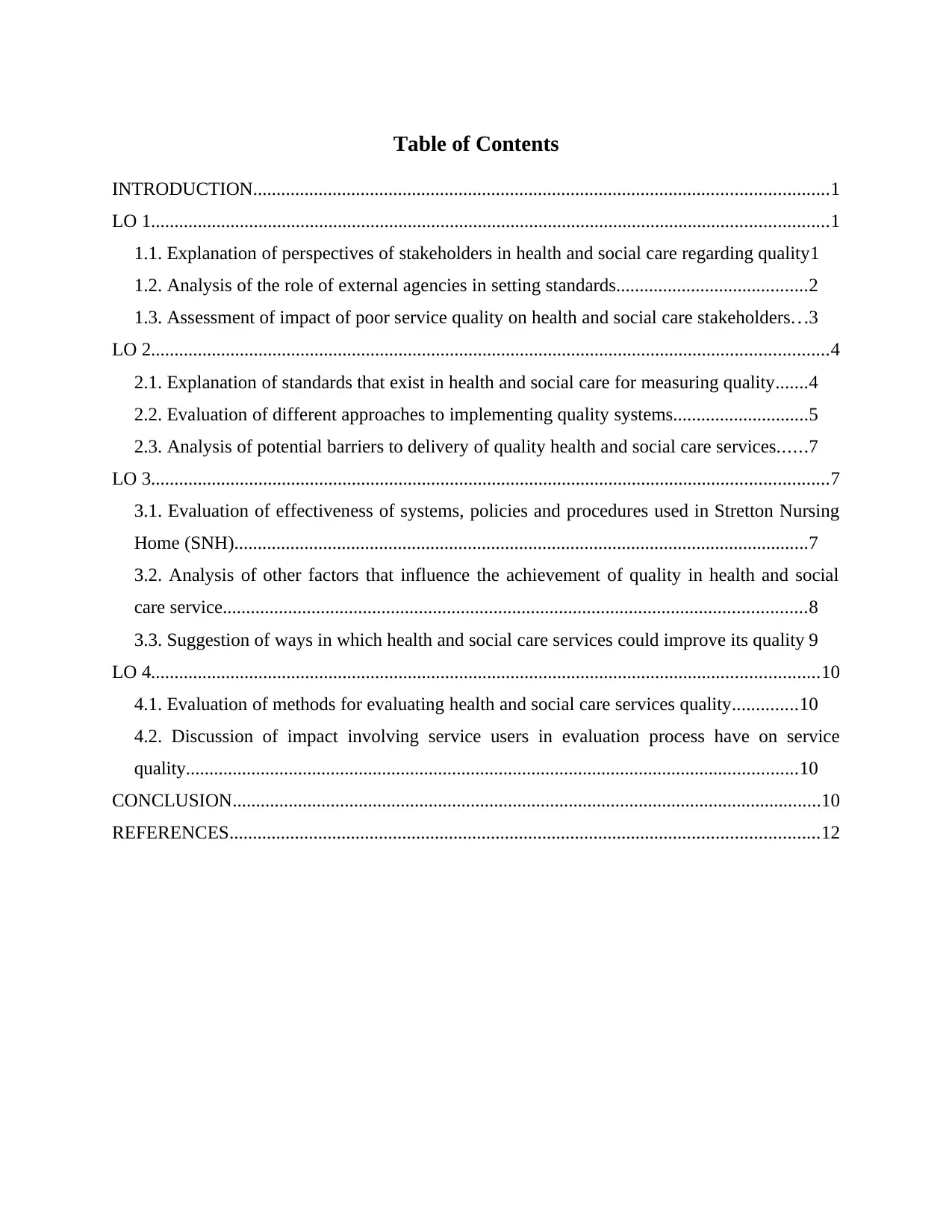
Table of Contents
INTRODUCTION...........................................................................................................................1
LO 1.................................................................................................................................................1
1.1. Explanation of perspectives of stakeholders in health and social care regarding quality1
1.2. Analysis of the role of external agencies in setting standards.........................................2
1.3. Assessment of impact of poor service quality on health and social care stakeholders.. .3
LO 2.................................................................................................................................................4
2.1. Explanation of standards that exist in health and social care for measuring quality.......4
2.2. Evaluation of different approaches to implementing quality systems.............................5
2.3. Analysis of potential barriers to delivery of quality health and social care services......7
LO 3.................................................................................................................................................7
3.1. Evaluation of effectiveness of systems, policies and procedures used in Stretton Nursing
Home (SNH)...........................................................................................................................7
3.2. Analysis of other factors that influence the achievement of quality in health and social
care service.............................................................................................................................8
3.3. Suggestion of ways in which health and social care services could improve its quality 9
LO 4...............................................................................................................................................10
4.1. Evaluation of methods for evaluating health and social care services quality..............10
4.2. Discussion of impact involving service users in evaluation process have on service
quality...................................................................................................................................10
CONCLUSION..............................................................................................................................10
REFERENCES..............................................................................................................................12
INTRODUCTION...........................................................................................................................1
LO 1.................................................................................................................................................1
1.1. Explanation of perspectives of stakeholders in health and social care regarding quality1
1.2. Analysis of the role of external agencies in setting standards.........................................2
1.3. Assessment of impact of poor service quality on health and social care stakeholders.. .3
LO 2.................................................................................................................................................4
2.1. Explanation of standards that exist in health and social care for measuring quality.......4
2.2. Evaluation of different approaches to implementing quality systems.............................5
2.3. Analysis of potential barriers to delivery of quality health and social care services......7
LO 3.................................................................................................................................................7
3.1. Evaluation of effectiveness of systems, policies and procedures used in Stretton Nursing
Home (SNH)...........................................................................................................................7
3.2. Analysis of other factors that influence the achievement of quality in health and social
care service.............................................................................................................................8
3.3. Suggestion of ways in which health and social care services could improve its quality 9
LO 4...............................................................................................................................................10
4.1. Evaluation of methods for evaluating health and social care services quality..............10
4.2. Discussion of impact involving service users in evaluation process have on service
quality...................................................................................................................................10
CONCLUSION..............................................................................................................................10
REFERENCES..............................................................................................................................12
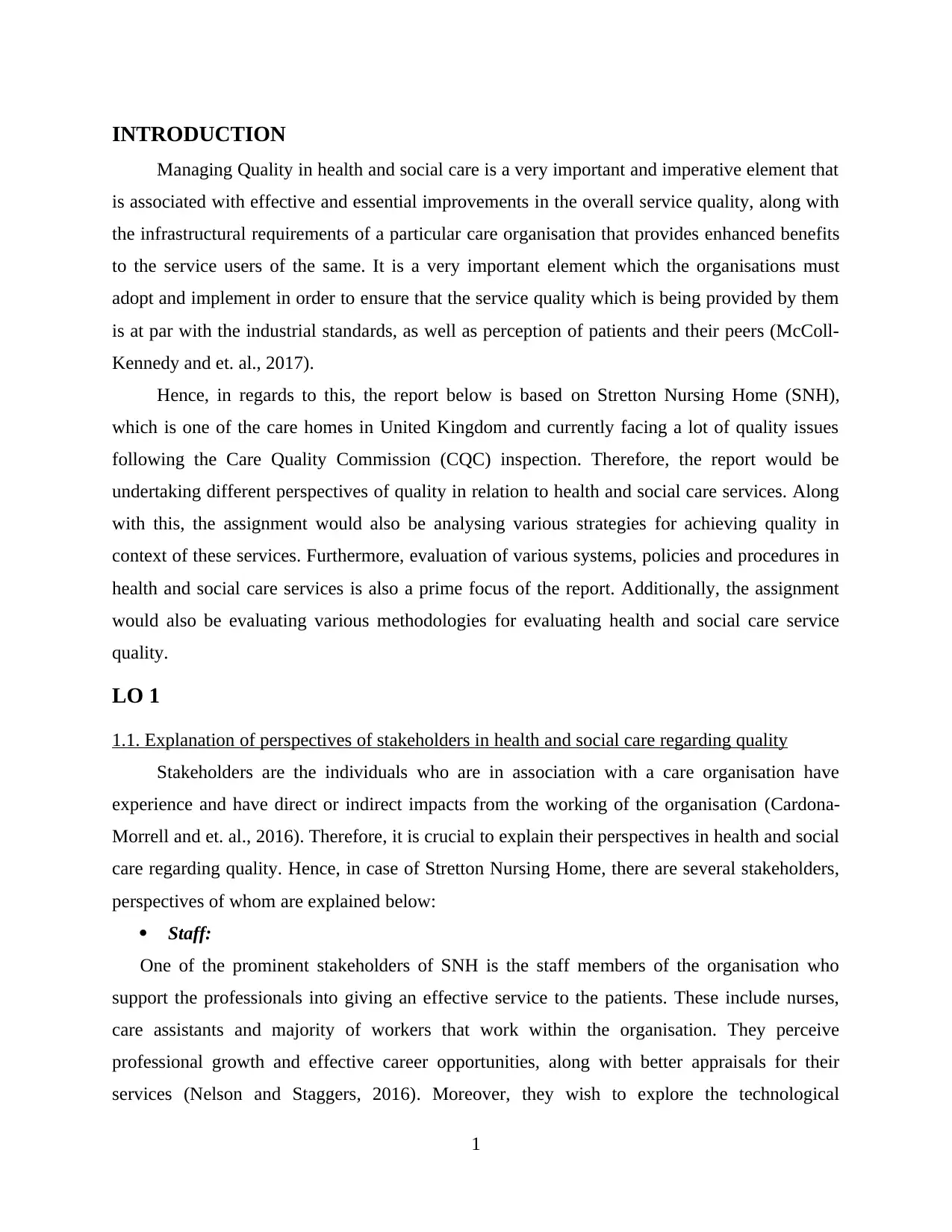
INTRODUCTION
Managing Quality in health and social care is a very important and imperative element that
is associated with effective and essential improvements in the overall service quality, along with
the infrastructural requirements of a particular care organisation that provides enhanced benefits
to the service users of the same. It is a very important element which the organisations must
adopt and implement in order to ensure that the service quality which is being provided by them
is at par with the industrial standards, as well as perception of patients and their peers (McColl-
Kennedy and et. al., 2017).
Hence, in regards to this, the report below is based on Stretton Nursing Home (SNH),
which is one of the care homes in United Kingdom and currently facing a lot of quality issues
following the Care Quality Commission (CQC) inspection. Therefore, the report would be
undertaking different perspectives of quality in relation to health and social care services. Along
with this, the assignment would also be analysing various strategies for achieving quality in
context of these services. Furthermore, evaluation of various systems, policies and procedures in
health and social care services is also a prime focus of the report. Additionally, the assignment
would also be evaluating various methodologies for evaluating health and social care service
quality.
LO 1
1.1. Explanation of perspectives of stakeholders in health and social care regarding quality
Stakeholders are the individuals who are in association with a care organisation have
experience and have direct or indirect impacts from the working of the organisation (Cardona-
Morrell and et. al., 2016). Therefore, it is crucial to explain their perspectives in health and social
care regarding quality. Hence, in case of Stretton Nursing Home, there are several stakeholders,
perspectives of whom are explained below:
Staff:
One of the prominent stakeholders of SNH is the staff members of the organisation who
support the professionals into giving an effective service to the patients. These include nurses,
care assistants and majority of workers that work within the organisation. They perceive
professional growth and effective career opportunities, along with better appraisals for their
services (Nelson and Staggers, 2016). Moreover, they wish to explore the technological
1
Managing Quality in health and social care is a very important and imperative element that
is associated with effective and essential improvements in the overall service quality, along with
the infrastructural requirements of a particular care organisation that provides enhanced benefits
to the service users of the same. It is a very important element which the organisations must
adopt and implement in order to ensure that the service quality which is being provided by them
is at par with the industrial standards, as well as perception of patients and their peers (McColl-
Kennedy and et. al., 2017).
Hence, in regards to this, the report below is based on Stretton Nursing Home (SNH),
which is one of the care homes in United Kingdom and currently facing a lot of quality issues
following the Care Quality Commission (CQC) inspection. Therefore, the report would be
undertaking different perspectives of quality in relation to health and social care services. Along
with this, the assignment would also be analysing various strategies for achieving quality in
context of these services. Furthermore, evaluation of various systems, policies and procedures in
health and social care services is also a prime focus of the report. Additionally, the assignment
would also be evaluating various methodologies for evaluating health and social care service
quality.
LO 1
1.1. Explanation of perspectives of stakeholders in health and social care regarding quality
Stakeholders are the individuals who are in association with a care organisation have
experience and have direct or indirect impacts from the working of the organisation (Cardona-
Morrell and et. al., 2016). Therefore, it is crucial to explain their perspectives in health and social
care regarding quality. Hence, in case of Stretton Nursing Home, there are several stakeholders,
perspectives of whom are explained below:
Staff:
One of the prominent stakeholders of SNH is the staff members of the organisation who
support the professionals into giving an effective service to the patients. These include nurses,
care assistants and majority of workers that work within the organisation. They perceive
professional growth and effective career opportunities, along with better appraisals for their
services (Nelson and Staggers, 2016). Moreover, they wish to explore the technological
1
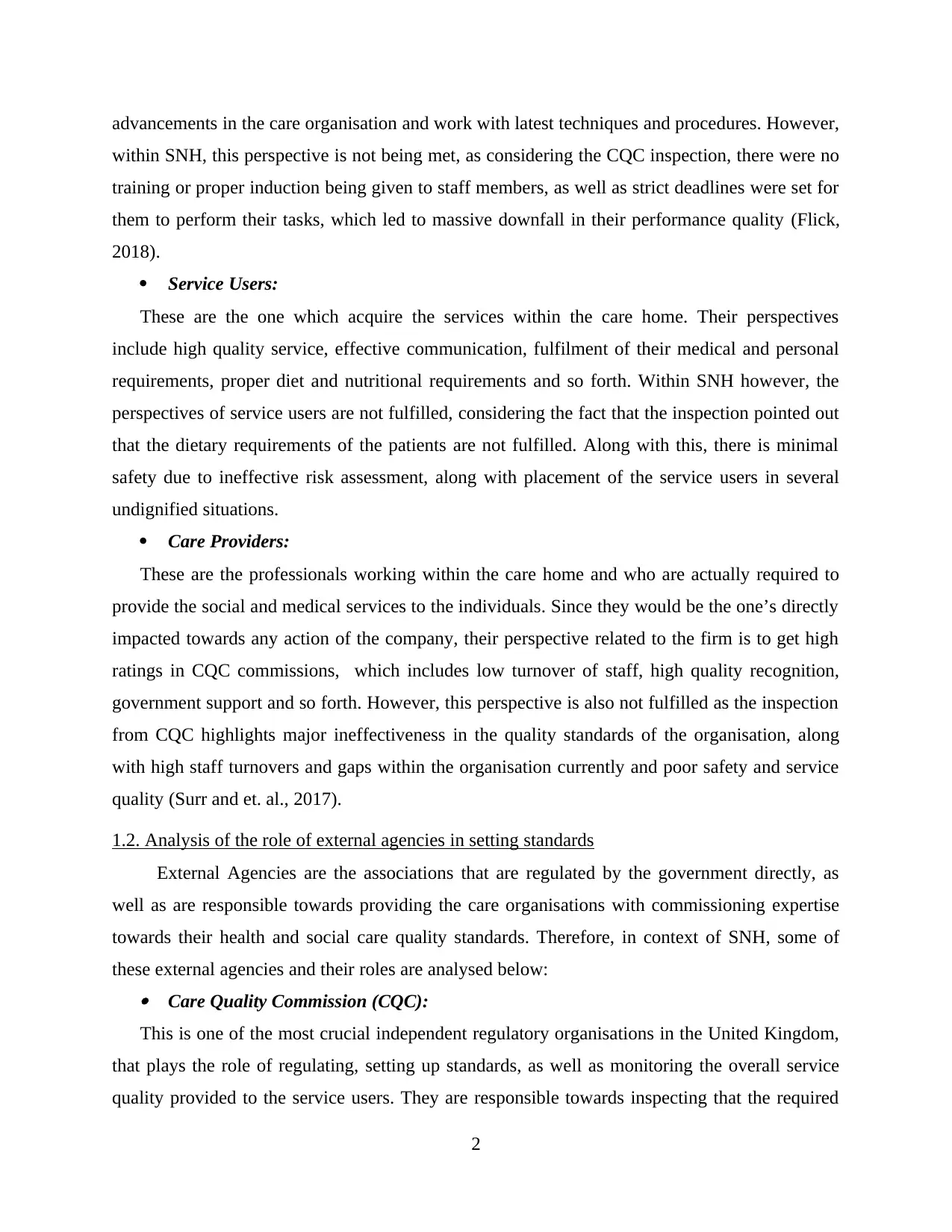
advancements in the care organisation and work with latest techniques and procedures. However,
within SNH, this perspective is not being met, as considering the CQC inspection, there were no
training or proper induction being given to staff members, as well as strict deadlines were set for
them to perform their tasks, which led to massive downfall in their performance quality (Flick,
2018).
Service Users:
These are the one which acquire the services within the care home. Their perspectives
include high quality service, effective communication, fulfilment of their medical and personal
requirements, proper diet and nutritional requirements and so forth. Within SNH however, the
perspectives of service users are not fulfilled, considering the fact that the inspection pointed out
that the dietary requirements of the patients are not fulfilled. Along with this, there is minimal
safety due to ineffective risk assessment, along with placement of the service users in several
undignified situations.
Care Providers:
These are the professionals working within the care home and who are actually required to
provide the social and medical services to the individuals. Since they would be the one’s directly
impacted towards any action of the company, their perspective related to the firm is to get high
ratings in CQC commissions, which includes low turnover of staff, high quality recognition,
government support and so forth. However, this perspective is also not fulfilled as the inspection
from CQC highlights major ineffectiveness in the quality standards of the organisation, along
with high staff turnovers and gaps within the organisation currently and poor safety and service
quality (Surr and et. al., 2017).
1.2. Analysis of the role of external agencies in setting standards
External Agencies are the associations that are regulated by the government directly, as
well as are responsible towards providing the care organisations with commissioning expertise
towards their health and social care quality standards. Therefore, in context of SNH, some of
these external agencies and their roles are analysed below: Care Quality Commission (CQC):
This is one of the most crucial independent regulatory organisations in the United Kingdom,
that plays the role of regulating, setting up standards, as well as monitoring the overall service
quality provided to the service users. They are responsible towards inspecting that the required
2
within SNH, this perspective is not being met, as considering the CQC inspection, there were no
training or proper induction being given to staff members, as well as strict deadlines were set for
them to perform their tasks, which led to massive downfall in their performance quality (Flick,
2018).
Service Users:
These are the one which acquire the services within the care home. Their perspectives
include high quality service, effective communication, fulfilment of their medical and personal
requirements, proper diet and nutritional requirements and so forth. Within SNH however, the
perspectives of service users are not fulfilled, considering the fact that the inspection pointed out
that the dietary requirements of the patients are not fulfilled. Along with this, there is minimal
safety due to ineffective risk assessment, along with placement of the service users in several
undignified situations.
Care Providers:
These are the professionals working within the care home and who are actually required to
provide the social and medical services to the individuals. Since they would be the one’s directly
impacted towards any action of the company, their perspective related to the firm is to get high
ratings in CQC commissions, which includes low turnover of staff, high quality recognition,
government support and so forth. However, this perspective is also not fulfilled as the inspection
from CQC highlights major ineffectiveness in the quality standards of the organisation, along
with high staff turnovers and gaps within the organisation currently and poor safety and service
quality (Surr and et. al., 2017).
1.2. Analysis of the role of external agencies in setting standards
External Agencies are the associations that are regulated by the government directly, as
well as are responsible towards providing the care organisations with commissioning expertise
towards their health and social care quality standards. Therefore, in context of SNH, some of
these external agencies and their roles are analysed below: Care Quality Commission (CQC):
This is one of the most crucial independent regulatory organisations in the United Kingdom,
that plays the role of regulating, setting up standards, as well as monitoring the overall service
quality provided to the service users. They are responsible towards inspecting that the required
2
Secure Best Marks with AI Grader
Need help grading? Try our AI Grader for instant feedback on your assignments.
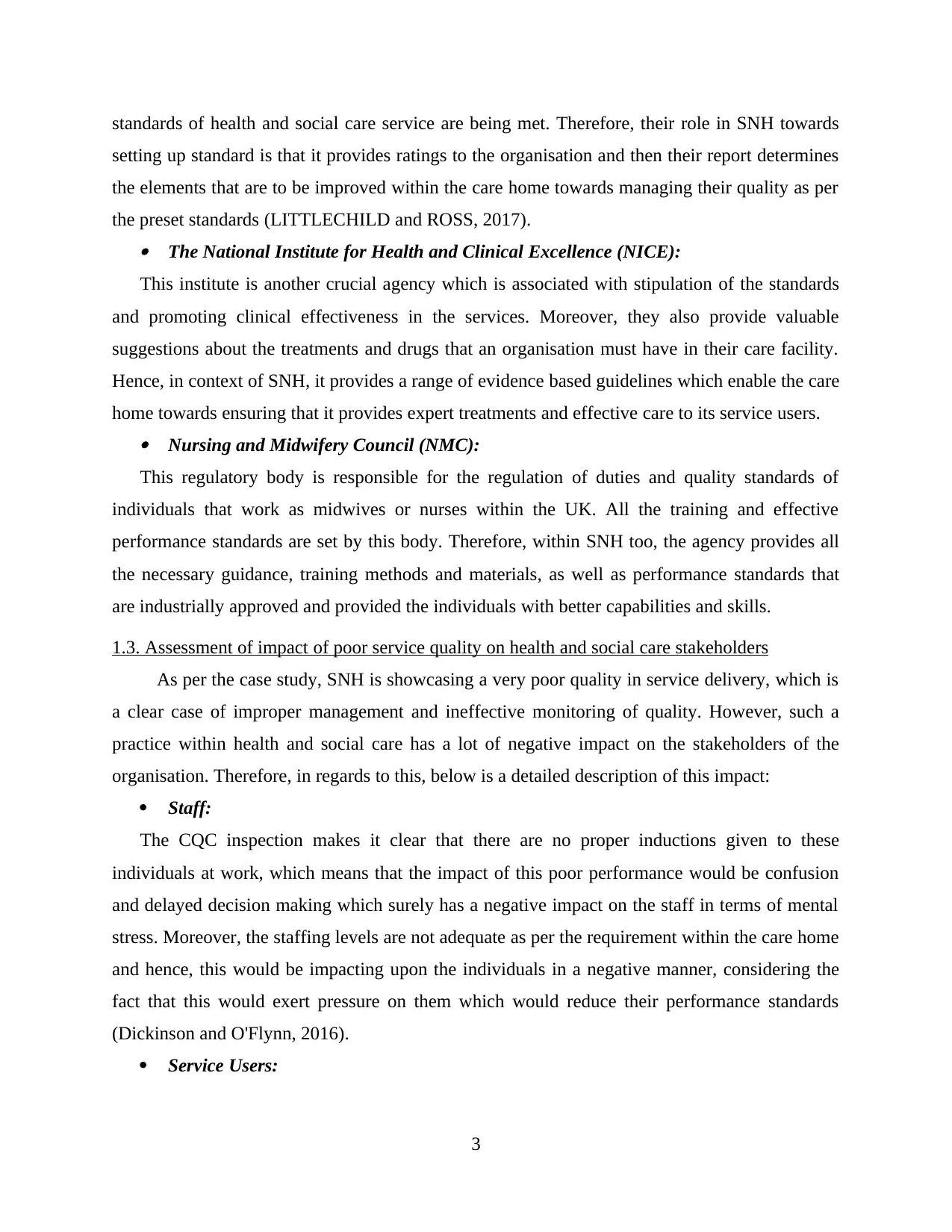
standards of health and social care service are being met. Therefore, their role in SNH towards
setting up standard is that it provides ratings to the organisation and then their report determines
the elements that are to be improved within the care home towards managing their quality as per
the preset standards (LITTLECHILD and ROSS, 2017). The National Institute for Health and Clinical Excellence (NICE):
This institute is another crucial agency which is associated with stipulation of the standards
and promoting clinical effectiveness in the services. Moreover, they also provide valuable
suggestions about the treatments and drugs that an organisation must have in their care facility.
Hence, in context of SNH, it provides a range of evidence based guidelines which enable the care
home towards ensuring that it provides expert treatments and effective care to its service users. Nursing and Midwifery Council (NMC):
This regulatory body is responsible for the regulation of duties and quality standards of
individuals that work as midwives or nurses within the UK. All the training and effective
performance standards are set by this body. Therefore, within SNH too, the agency provides all
the necessary guidance, training methods and materials, as well as performance standards that
are industrially approved and provided the individuals with better capabilities and skills.
1.3. Assessment of impact of poor service quality on health and social care stakeholders
As per the case study, SNH is showcasing a very poor quality in service delivery, which is
a clear case of improper management and ineffective monitoring of quality. However, such a
practice within health and social care has a lot of negative impact on the stakeholders of the
organisation. Therefore, in regards to this, below is a detailed description of this impact:
Staff:
The CQC inspection makes it clear that there are no proper inductions given to these
individuals at work, which means that the impact of this poor performance would be confusion
and delayed decision making which surely has a negative impact on the staff in terms of mental
stress. Moreover, the staffing levels are not adequate as per the requirement within the care home
and hence, this would be impacting upon the individuals in a negative manner, considering the
fact that this would exert pressure on them which would reduce their performance standards
(Dickinson and O'Flynn, 2016).
Service Users:
3
setting up standard is that it provides ratings to the organisation and then their report determines
the elements that are to be improved within the care home towards managing their quality as per
the preset standards (LITTLECHILD and ROSS, 2017). The National Institute for Health and Clinical Excellence (NICE):
This institute is another crucial agency which is associated with stipulation of the standards
and promoting clinical effectiveness in the services. Moreover, they also provide valuable
suggestions about the treatments and drugs that an organisation must have in their care facility.
Hence, in context of SNH, it provides a range of evidence based guidelines which enable the care
home towards ensuring that it provides expert treatments and effective care to its service users. Nursing and Midwifery Council (NMC):
This regulatory body is responsible for the regulation of duties and quality standards of
individuals that work as midwives or nurses within the UK. All the training and effective
performance standards are set by this body. Therefore, within SNH too, the agency provides all
the necessary guidance, training methods and materials, as well as performance standards that
are industrially approved and provided the individuals with better capabilities and skills.
1.3. Assessment of impact of poor service quality on health and social care stakeholders
As per the case study, SNH is showcasing a very poor quality in service delivery, which is
a clear case of improper management and ineffective monitoring of quality. However, such a
practice within health and social care has a lot of negative impact on the stakeholders of the
organisation. Therefore, in regards to this, below is a detailed description of this impact:
Staff:
The CQC inspection makes it clear that there are no proper inductions given to these
individuals at work, which means that the impact of this poor performance would be confusion
and delayed decision making which surely has a negative impact on the staff in terms of mental
stress. Moreover, the staffing levels are not adequate as per the requirement within the care home
and hence, this would be impacting upon the individuals in a negative manner, considering the
fact that this would exert pressure on them which would reduce their performance standards
(Dickinson and O'Flynn, 2016).
Service Users:
3
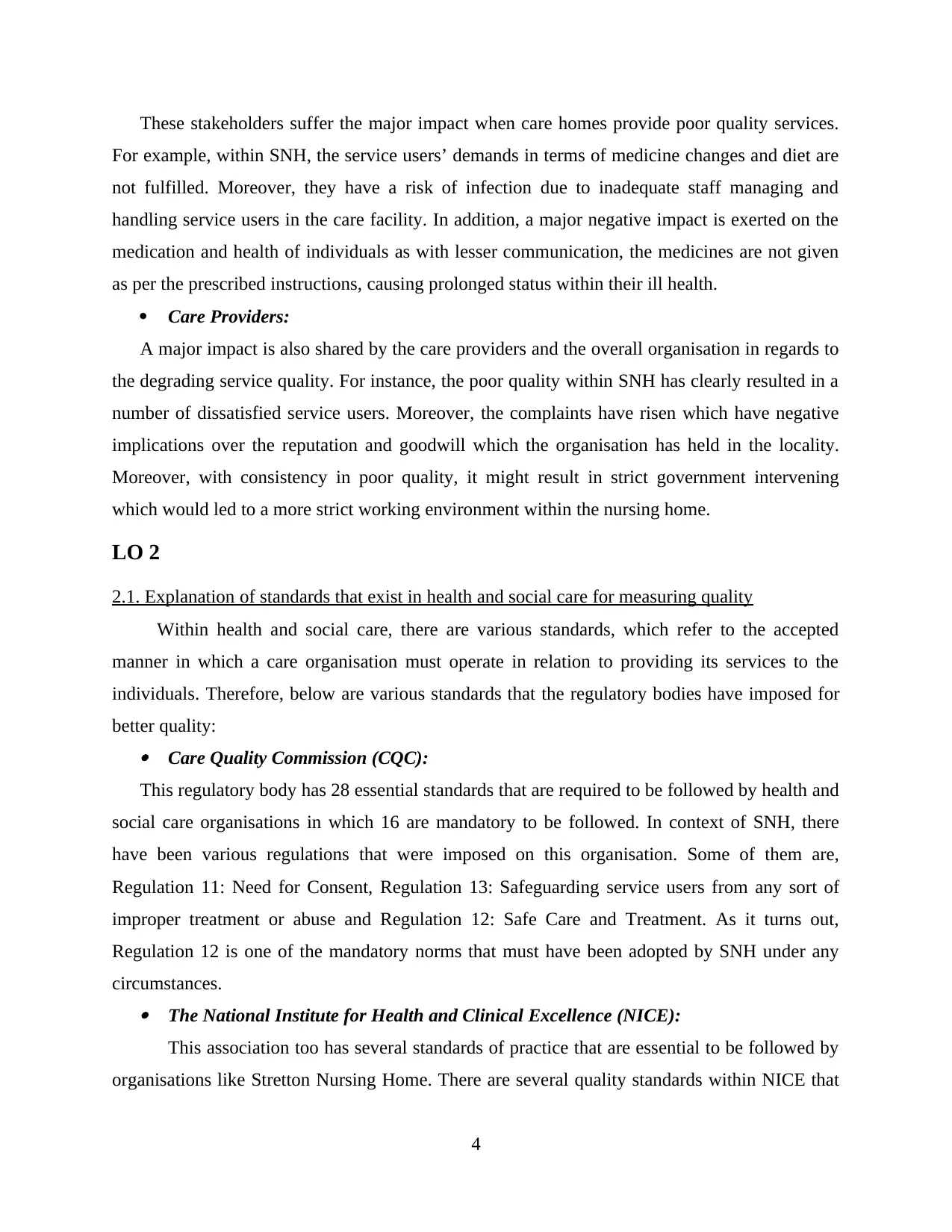
These stakeholders suffer the major impact when care homes provide poor quality services.
For example, within SNH, the service users’ demands in terms of medicine changes and diet are
not fulfilled. Moreover, they have a risk of infection due to inadequate staff managing and
handling service users in the care facility. In addition, a major negative impact is exerted on the
medication and health of individuals as with lesser communication, the medicines are not given
as per the prescribed instructions, causing prolonged status within their ill health.
Care Providers:
A major impact is also shared by the care providers and the overall organisation in regards to
the degrading service quality. For instance, the poor quality within SNH has clearly resulted in a
number of dissatisfied service users. Moreover, the complaints have risen which have negative
implications over the reputation and goodwill which the organisation has held in the locality.
Moreover, with consistency in poor quality, it might result in strict government intervening
which would led to a more strict working environment within the nursing home.
LO 2
2.1. Explanation of standards that exist in health and social care for measuring quality
Within health and social care, there are various standards, which refer to the accepted
manner in which a care organisation must operate in relation to providing its services to the
individuals. Therefore, below are various standards that the regulatory bodies have imposed for
better quality: Care Quality Commission (CQC):
This regulatory body has 28 essential standards that are required to be followed by health and
social care organisations in which 16 are mandatory to be followed. In context of SNH, there
have been various regulations that were imposed on this organisation. Some of them are,
Regulation 11: Need for Consent, Regulation 13: Safeguarding service users from any sort of
improper treatment or abuse and Regulation 12: Safe Care and Treatment. As it turns out,
Regulation 12 is one of the mandatory norms that must have been adopted by SNH under any
circumstances. The National Institute for Health and Clinical Excellence (NICE):
This association too has several standards of practice that are essential to be followed by
organisations like Stretton Nursing Home. There are several quality standards within NICE that
4
For example, within SNH, the service users’ demands in terms of medicine changes and diet are
not fulfilled. Moreover, they have a risk of infection due to inadequate staff managing and
handling service users in the care facility. In addition, a major negative impact is exerted on the
medication and health of individuals as with lesser communication, the medicines are not given
as per the prescribed instructions, causing prolonged status within their ill health.
Care Providers:
A major impact is also shared by the care providers and the overall organisation in regards to
the degrading service quality. For instance, the poor quality within SNH has clearly resulted in a
number of dissatisfied service users. Moreover, the complaints have risen which have negative
implications over the reputation and goodwill which the organisation has held in the locality.
Moreover, with consistency in poor quality, it might result in strict government intervening
which would led to a more strict working environment within the nursing home.
LO 2
2.1. Explanation of standards that exist in health and social care for measuring quality
Within health and social care, there are various standards, which refer to the accepted
manner in which a care organisation must operate in relation to providing its services to the
individuals. Therefore, below are various standards that the regulatory bodies have imposed for
better quality: Care Quality Commission (CQC):
This regulatory body has 28 essential standards that are required to be followed by health and
social care organisations in which 16 are mandatory to be followed. In context of SNH, there
have been various regulations that were imposed on this organisation. Some of them are,
Regulation 11: Need for Consent, Regulation 13: Safeguarding service users from any sort of
improper treatment or abuse and Regulation 12: Safe Care and Treatment. As it turns out,
Regulation 12 is one of the mandatory norms that must have been adopted by SNH under any
circumstances. The National Institute for Health and Clinical Excellence (NICE):
This association too has several standards of practice that are essential to be followed by
organisations like Stretton Nursing Home. There are several quality standards within NICE that
4
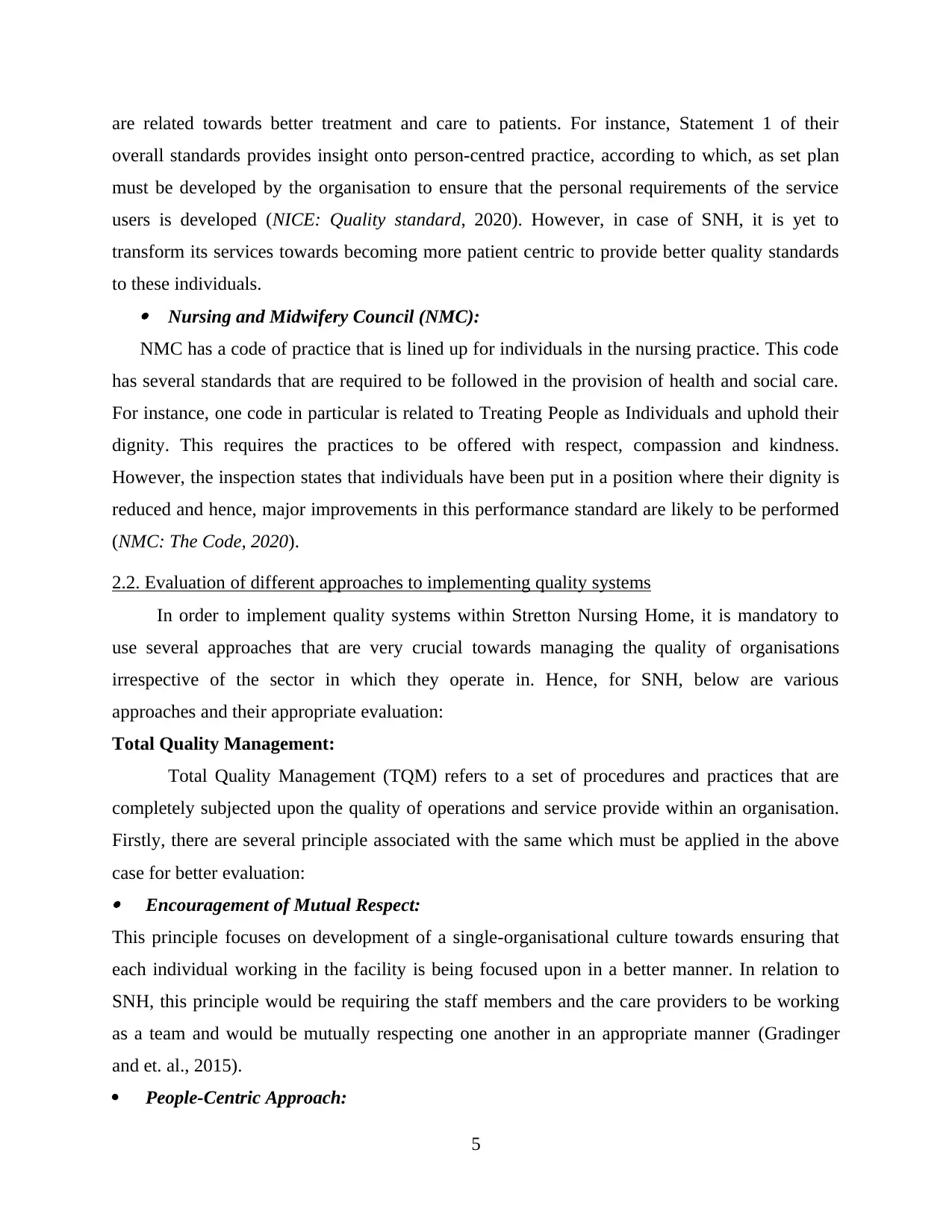
are related towards better treatment and care to patients. For instance, Statement 1 of their
overall standards provides insight onto person-centred practice, according to which, as set plan
must be developed by the organisation to ensure that the personal requirements of the service
users is developed (NICE: Quality standard, 2020). However, in case of SNH, it is yet to
transform its services towards becoming more patient centric to provide better quality standards
to these individuals. Nursing and Midwifery Council (NMC):
NMC has a code of practice that is lined up for individuals in the nursing practice. This code
has several standards that are required to be followed in the provision of health and social care.
For instance, one code in particular is related to Treating People as Individuals and uphold their
dignity. This requires the practices to be offered with respect, compassion and kindness.
However, the inspection states that individuals have been put in a position where their dignity is
reduced and hence, major improvements in this performance standard are likely to be performed
(NMC: The Code, 2020).
2.2. Evaluation of different approaches to implementing quality systems
In order to implement quality systems within Stretton Nursing Home, it is mandatory to
use several approaches that are very crucial towards managing the quality of organisations
irrespective of the sector in which they operate in. Hence, for SNH, below are various
approaches and their appropriate evaluation:
Total Quality Management:
Total Quality Management (TQM) refers to a set of procedures and practices that are
completely subjected upon the quality of operations and service provide within an organisation.
Firstly, there are several principle associated with the same which must be applied in the above
case for better evaluation: Encouragement of Mutual Respect:
This principle focuses on development of a single-organisational culture towards ensuring that
each individual working in the facility is being focused upon in a better manner. In relation to
SNH, this principle would be requiring the staff members and the care providers to be working
as a team and would be mutually respecting one another in an appropriate manner (Gradinger
and et. al., 2015).
People-Centric Approach:
5
overall standards provides insight onto person-centred practice, according to which, as set plan
must be developed by the organisation to ensure that the personal requirements of the service
users is developed (NICE: Quality standard, 2020). However, in case of SNH, it is yet to
transform its services towards becoming more patient centric to provide better quality standards
to these individuals. Nursing and Midwifery Council (NMC):
NMC has a code of practice that is lined up for individuals in the nursing practice. This code
has several standards that are required to be followed in the provision of health and social care.
For instance, one code in particular is related to Treating People as Individuals and uphold their
dignity. This requires the practices to be offered with respect, compassion and kindness.
However, the inspection states that individuals have been put in a position where their dignity is
reduced and hence, major improvements in this performance standard are likely to be performed
(NMC: The Code, 2020).
2.2. Evaluation of different approaches to implementing quality systems
In order to implement quality systems within Stretton Nursing Home, it is mandatory to
use several approaches that are very crucial towards managing the quality of organisations
irrespective of the sector in which they operate in. Hence, for SNH, below are various
approaches and their appropriate evaluation:
Total Quality Management:
Total Quality Management (TQM) refers to a set of procedures and practices that are
completely subjected upon the quality of operations and service provide within an organisation.
Firstly, there are several principle associated with the same which must be applied in the above
case for better evaluation: Encouragement of Mutual Respect:
This principle focuses on development of a single-organisational culture towards ensuring that
each individual working in the facility is being focused upon in a better manner. In relation to
SNH, this principle would be requiring the staff members and the care providers to be working
as a team and would be mutually respecting one another in an appropriate manner (Gradinger
and et. al., 2015).
People-Centric Approach:
5
Paraphrase This Document
Need a fresh take? Get an instant paraphrase of this document with our AI Paraphraser
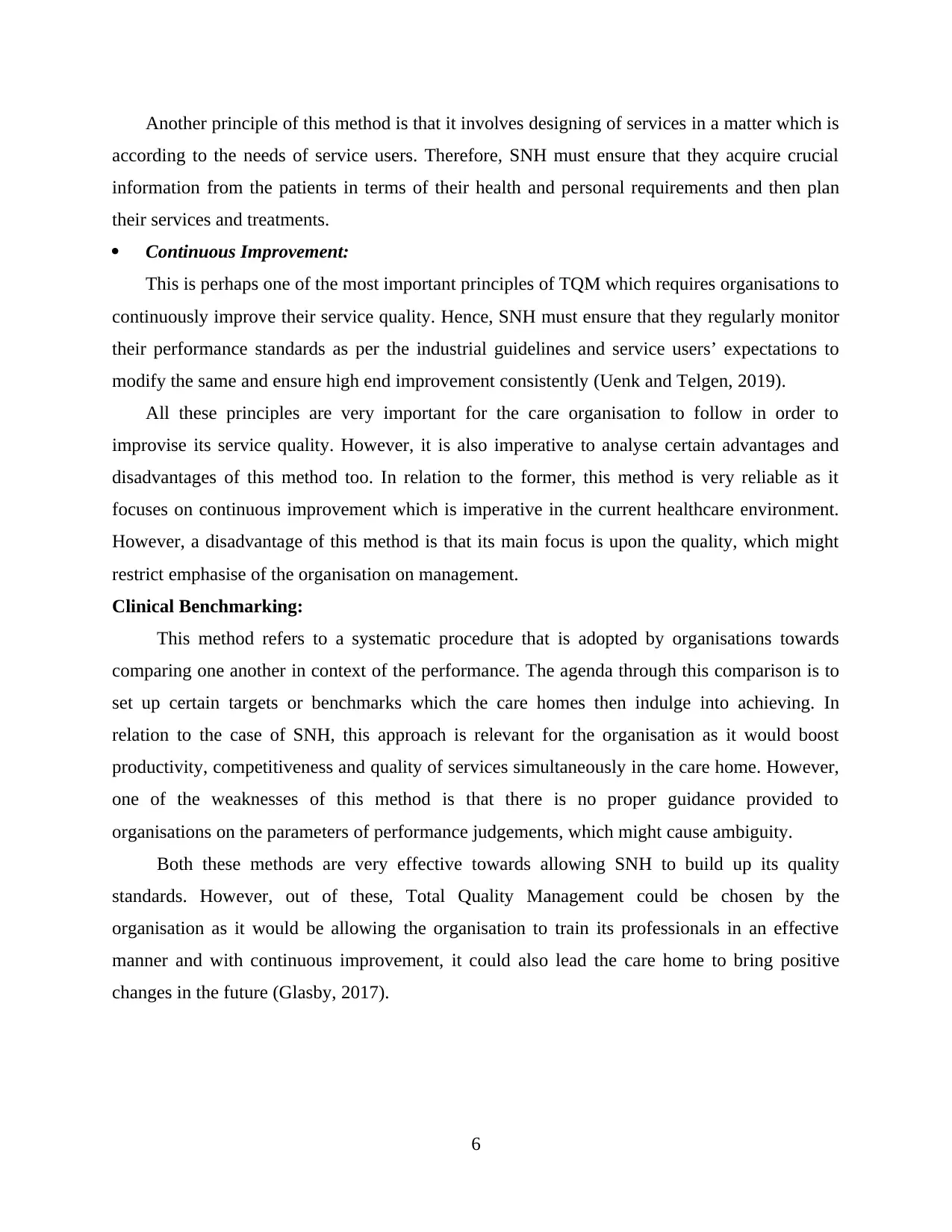
Another principle of this method is that it involves designing of services in a matter which is
according to the needs of service users. Therefore, SNH must ensure that they acquire crucial
information from the patients in terms of their health and personal requirements and then plan
their services and treatments.
Continuous Improvement:
This is perhaps one of the most important principles of TQM which requires organisations to
continuously improve their service quality. Hence, SNH must ensure that they regularly monitor
their performance standards as per the industrial guidelines and service users’ expectations to
modify the same and ensure high end improvement consistently (Uenk and Telgen, 2019).
All these principles are very important for the care organisation to follow in order to
improvise its service quality. However, it is also imperative to analyse certain advantages and
disadvantages of this method too. In relation to the former, this method is very reliable as it
focuses on continuous improvement which is imperative in the current healthcare environment.
However, a disadvantage of this method is that its main focus is upon the quality, which might
restrict emphasise of the organisation on management.
Clinical Benchmarking:
This method refers to a systematic procedure that is adopted by organisations towards
comparing one another in context of the performance. The agenda through this comparison is to
set up certain targets or benchmarks which the care homes then indulge into achieving. In
relation to the case of SNH, this approach is relevant for the organisation as it would boost
productivity, competitiveness and quality of services simultaneously in the care home. However,
one of the weaknesses of this method is that there is no proper guidance provided to
organisations on the parameters of performance judgements, which might cause ambiguity.
Both these methods are very effective towards allowing SNH to build up its quality
standards. However, out of these, Total Quality Management could be chosen by the
organisation as it would be allowing the organisation to train its professionals in an effective
manner and with continuous improvement, it could also lead the care home to bring positive
changes in the future (Glasby, 2017).
6
according to the needs of service users. Therefore, SNH must ensure that they acquire crucial
information from the patients in terms of their health and personal requirements and then plan
their services and treatments.
Continuous Improvement:
This is perhaps one of the most important principles of TQM which requires organisations to
continuously improve their service quality. Hence, SNH must ensure that they regularly monitor
their performance standards as per the industrial guidelines and service users’ expectations to
modify the same and ensure high end improvement consistently (Uenk and Telgen, 2019).
All these principles are very important for the care organisation to follow in order to
improvise its service quality. However, it is also imperative to analyse certain advantages and
disadvantages of this method too. In relation to the former, this method is very reliable as it
focuses on continuous improvement which is imperative in the current healthcare environment.
However, a disadvantage of this method is that its main focus is upon the quality, which might
restrict emphasise of the organisation on management.
Clinical Benchmarking:
This method refers to a systematic procedure that is adopted by organisations towards
comparing one another in context of the performance. The agenda through this comparison is to
set up certain targets or benchmarks which the care homes then indulge into achieving. In
relation to the case of SNH, this approach is relevant for the organisation as it would boost
productivity, competitiveness and quality of services simultaneously in the care home. However,
one of the weaknesses of this method is that there is no proper guidance provided to
organisations on the parameters of performance judgements, which might cause ambiguity.
Both these methods are very effective towards allowing SNH to build up its quality
standards. However, out of these, Total Quality Management could be chosen by the
organisation as it would be allowing the organisation to train its professionals in an effective
manner and with continuous improvement, it could also lead the care home to bring positive
changes in the future (Glasby, 2017).
6
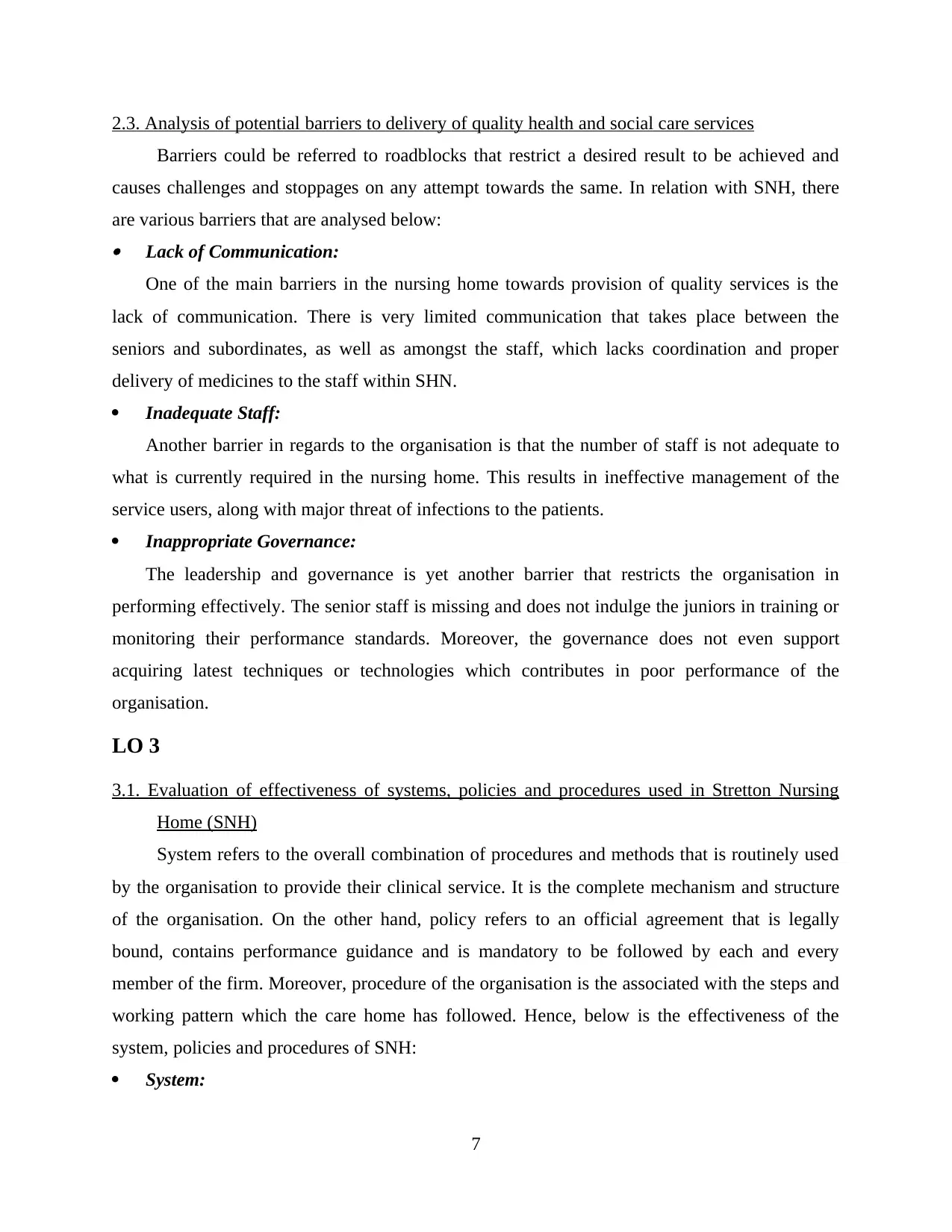
2.3. Analysis of potential barriers to delivery of quality health and social care services
Barriers could be referred to roadblocks that restrict a desired result to be achieved and
causes challenges and stoppages on any attempt towards the same. In relation with SNH, there
are various barriers that are analysed below: Lack of Communication:
One of the main barriers in the nursing home towards provision of quality services is the
lack of communication. There is very limited communication that takes place between the
seniors and subordinates, as well as amongst the staff, which lacks coordination and proper
delivery of medicines to the staff within SHN.
Inadequate Staff:
Another barrier in regards to the organisation is that the number of staff is not adequate to
what is currently required in the nursing home. This results in ineffective management of the
service users, along with major threat of infections to the patients.
Inappropriate Governance:
The leadership and governance is yet another barrier that restricts the organisation in
performing effectively. The senior staff is missing and does not indulge the juniors in training or
monitoring their performance standards. Moreover, the governance does not even support
acquiring latest techniques or technologies which contributes in poor performance of the
organisation.
LO 3
3.1. Evaluation of effectiveness of systems, policies and procedures used in Stretton Nursing
Home (SNH)
System refers to the overall combination of procedures and methods that is routinely used
by the organisation to provide their clinical service. It is the complete mechanism and structure
of the organisation. On the other hand, policy refers to an official agreement that is legally
bound, contains performance guidance and is mandatory to be followed by each and every
member of the firm. Moreover, procedure of the organisation is the associated with the steps and
working pattern which the care home has followed. Hence, below is the effectiveness of the
system, policies and procedures of SNH:
System:
7
Barriers could be referred to roadblocks that restrict a desired result to be achieved and
causes challenges and stoppages on any attempt towards the same. In relation with SNH, there
are various barriers that are analysed below: Lack of Communication:
One of the main barriers in the nursing home towards provision of quality services is the
lack of communication. There is very limited communication that takes place between the
seniors and subordinates, as well as amongst the staff, which lacks coordination and proper
delivery of medicines to the staff within SHN.
Inadequate Staff:
Another barrier in regards to the organisation is that the number of staff is not adequate to
what is currently required in the nursing home. This results in ineffective management of the
service users, along with major threat of infections to the patients.
Inappropriate Governance:
The leadership and governance is yet another barrier that restricts the organisation in
performing effectively. The senior staff is missing and does not indulge the juniors in training or
monitoring their performance standards. Moreover, the governance does not even support
acquiring latest techniques or technologies which contributes in poor performance of the
organisation.
LO 3
3.1. Evaluation of effectiveness of systems, policies and procedures used in Stretton Nursing
Home (SNH)
System refers to the overall combination of procedures and methods that is routinely used
by the organisation to provide their clinical service. It is the complete mechanism and structure
of the organisation. On the other hand, policy refers to an official agreement that is legally
bound, contains performance guidance and is mandatory to be followed by each and every
member of the firm. Moreover, procedure of the organisation is the associated with the steps and
working pattern which the care home has followed. Hence, below is the effectiveness of the
system, policies and procedures of SNH:
System:
7
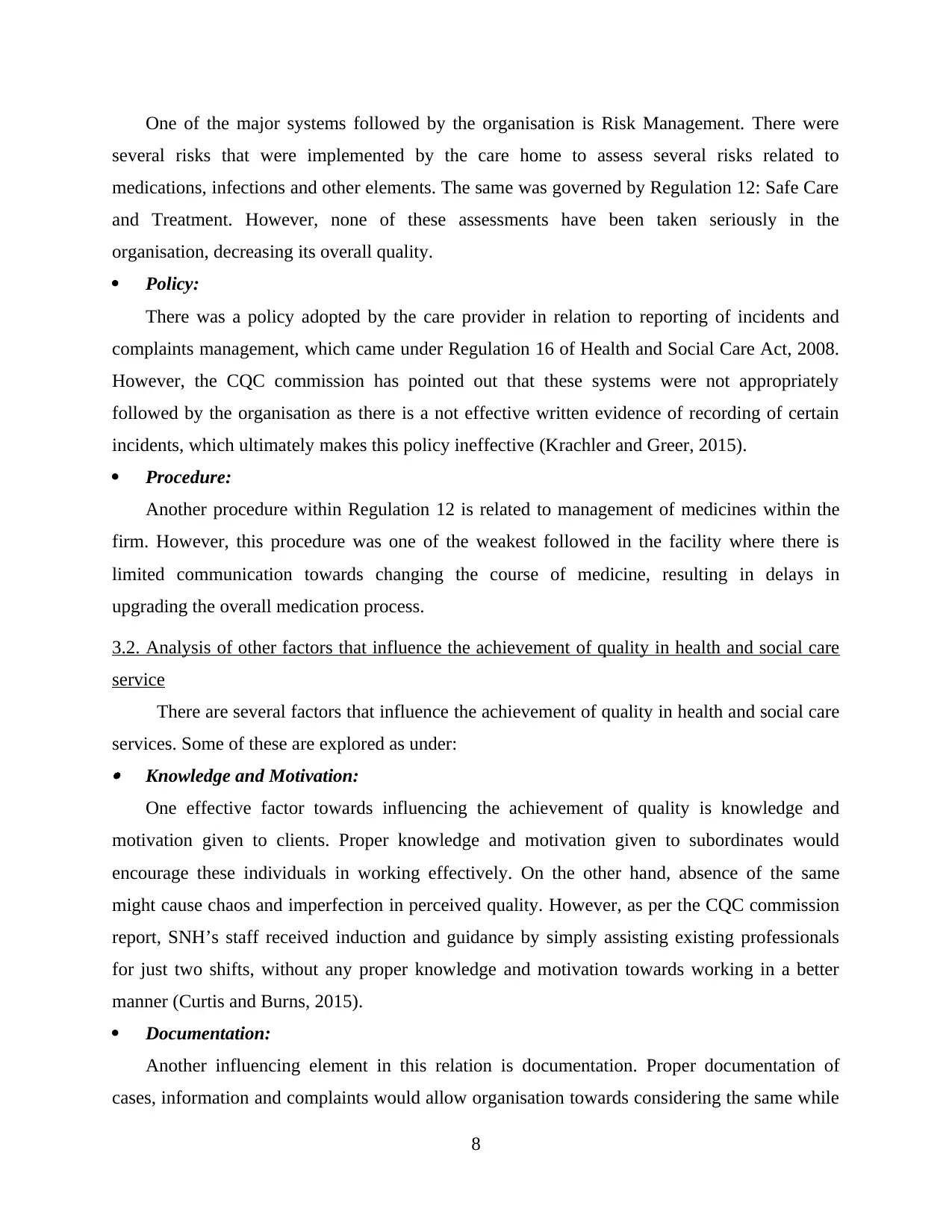
One of the major systems followed by the organisation is Risk Management. There were
several risks that were implemented by the care home to assess several risks related to
medications, infections and other elements. The same was governed by Regulation 12: Safe Care
and Treatment. However, none of these assessments have been taken seriously in the
organisation, decreasing its overall quality.
Policy:
There was a policy adopted by the care provider in relation to reporting of incidents and
complaints management, which came under Regulation 16 of Health and Social Care Act, 2008.
However, the CQC commission has pointed out that these systems were not appropriately
followed by the organisation as there is a not effective written evidence of recording of certain
incidents, which ultimately makes this policy ineffective (Krachler and Greer, 2015).
Procedure:
Another procedure within Regulation 12 is related to management of medicines within the
firm. However, this procedure was one of the weakest followed in the facility where there is
limited communication towards changing the course of medicine, resulting in delays in
upgrading the overall medication process.
3.2. Analysis of other factors that influence the achievement of quality in health and social care
service
There are several factors that influence the achievement of quality in health and social care
services. Some of these are explored as under: Knowledge and Motivation:
One effective factor towards influencing the achievement of quality is knowledge and
motivation given to clients. Proper knowledge and motivation given to subordinates would
encourage these individuals in working effectively. On the other hand, absence of the same
might cause chaos and imperfection in perceived quality. However, as per the CQC commission
report, SNH’s staff received induction and guidance by simply assisting existing professionals
for just two shifts, without any proper knowledge and motivation towards working in a better
manner (Curtis and Burns, 2015).
Documentation:
Another influencing element in this relation is documentation. Proper documentation of
cases, information and complaints would allow organisation towards considering the same while
8
several risks that were implemented by the care home to assess several risks related to
medications, infections and other elements. The same was governed by Regulation 12: Safe Care
and Treatment. However, none of these assessments have been taken seriously in the
organisation, decreasing its overall quality.
Policy:
There was a policy adopted by the care provider in relation to reporting of incidents and
complaints management, which came under Regulation 16 of Health and Social Care Act, 2008.
However, the CQC commission has pointed out that these systems were not appropriately
followed by the organisation as there is a not effective written evidence of recording of certain
incidents, which ultimately makes this policy ineffective (Krachler and Greer, 2015).
Procedure:
Another procedure within Regulation 12 is related to management of medicines within the
firm. However, this procedure was one of the weakest followed in the facility where there is
limited communication towards changing the course of medicine, resulting in delays in
upgrading the overall medication process.
3.2. Analysis of other factors that influence the achievement of quality in health and social care
service
There are several factors that influence the achievement of quality in health and social care
services. Some of these are explored as under: Knowledge and Motivation:
One effective factor towards influencing the achievement of quality is knowledge and
motivation given to clients. Proper knowledge and motivation given to subordinates would
encourage these individuals in working effectively. On the other hand, absence of the same
might cause chaos and imperfection in perceived quality. However, as per the CQC commission
report, SNH’s staff received induction and guidance by simply assisting existing professionals
for just two shifts, without any proper knowledge and motivation towards working in a better
manner (Curtis and Burns, 2015).
Documentation:
Another influencing element in this relation is documentation. Proper documentation of
cases, information and complaints would allow organisation towards considering the same while
8
Secure Best Marks with AI Grader
Need help grading? Try our AI Grader for instant feedback on your assignments.
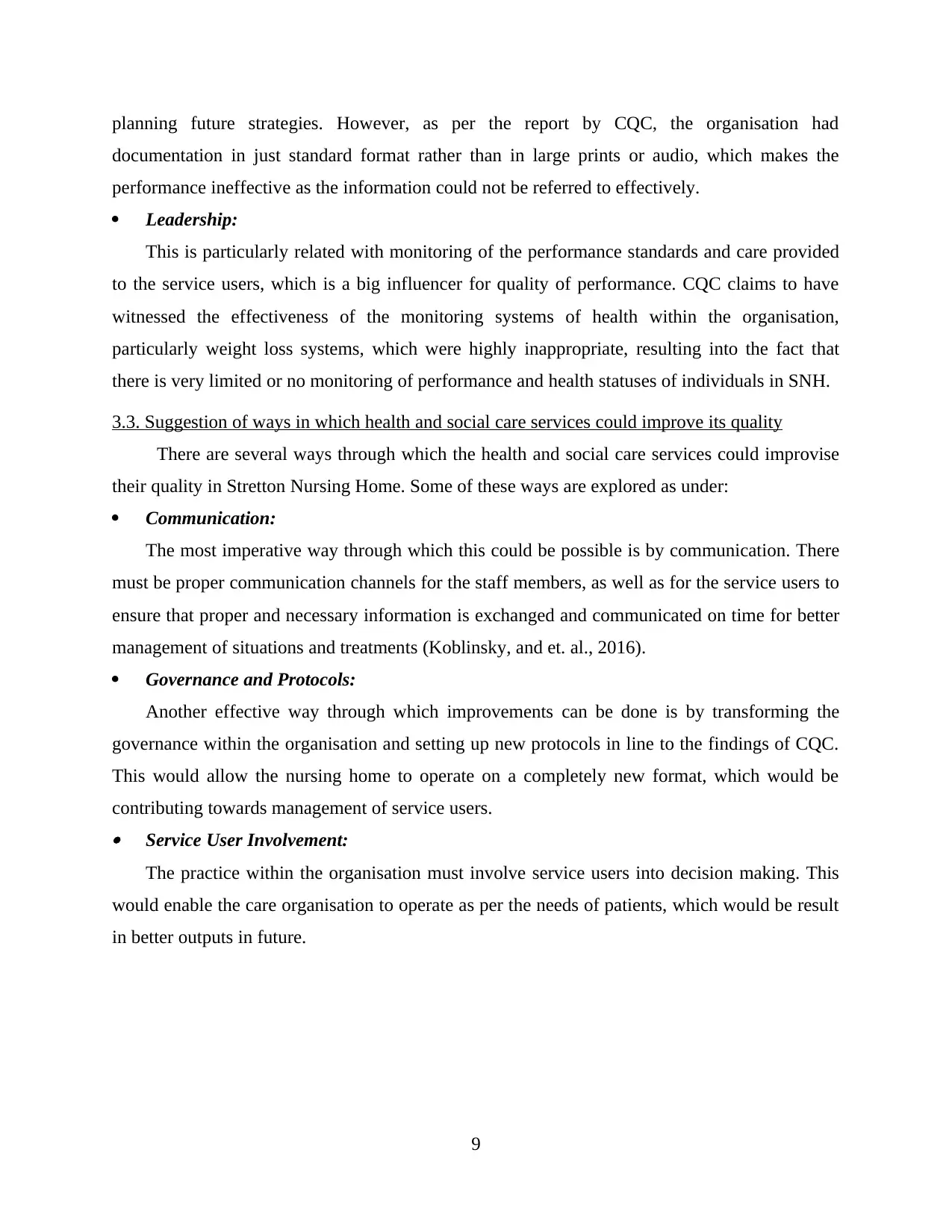
planning future strategies. However, as per the report by CQC, the organisation had
documentation in just standard format rather than in large prints or audio, which makes the
performance ineffective as the information could not be referred to effectively.
Leadership:
This is particularly related with monitoring of the performance standards and care provided
to the service users, which is a big influencer for quality of performance. CQC claims to have
witnessed the effectiveness of the monitoring systems of health within the organisation,
particularly weight loss systems, which were highly inappropriate, resulting into the fact that
there is very limited or no monitoring of performance and health statuses of individuals in SNH.
3.3. Suggestion of ways in which health and social care services could improve its quality
There are several ways through which the health and social care services could improvise
their quality in Stretton Nursing Home. Some of these ways are explored as under:
Communication:
The most imperative way through which this could be possible is by communication. There
must be proper communication channels for the staff members, as well as for the service users to
ensure that proper and necessary information is exchanged and communicated on time for better
management of situations and treatments (Koblinsky, and et. al., 2016).
Governance and Protocols:
Another effective way through which improvements can be done is by transforming the
governance within the organisation and setting up new protocols in line to the findings of CQC.
This would allow the nursing home to operate on a completely new format, which would be
contributing towards management of service users. Service User Involvement:
The practice within the organisation must involve service users into decision making. This
would enable the care organisation to operate as per the needs of patients, which would be result
in better outputs in future.
9
documentation in just standard format rather than in large prints or audio, which makes the
performance ineffective as the information could not be referred to effectively.
Leadership:
This is particularly related with monitoring of the performance standards and care provided
to the service users, which is a big influencer for quality of performance. CQC claims to have
witnessed the effectiveness of the monitoring systems of health within the organisation,
particularly weight loss systems, which were highly inappropriate, resulting into the fact that
there is very limited or no monitoring of performance and health statuses of individuals in SNH.
3.3. Suggestion of ways in which health and social care services could improve its quality
There are several ways through which the health and social care services could improvise
their quality in Stretton Nursing Home. Some of these ways are explored as under:
Communication:
The most imperative way through which this could be possible is by communication. There
must be proper communication channels for the staff members, as well as for the service users to
ensure that proper and necessary information is exchanged and communicated on time for better
management of situations and treatments (Koblinsky, and et. al., 2016).
Governance and Protocols:
Another effective way through which improvements can be done is by transforming the
governance within the organisation and setting up new protocols in line to the findings of CQC.
This would allow the nursing home to operate on a completely new format, which would be
contributing towards management of service users. Service User Involvement:
The practice within the organisation must involve service users into decision making. This
would enable the care organisation to operate as per the needs of patients, which would be result
in better outputs in future.
9
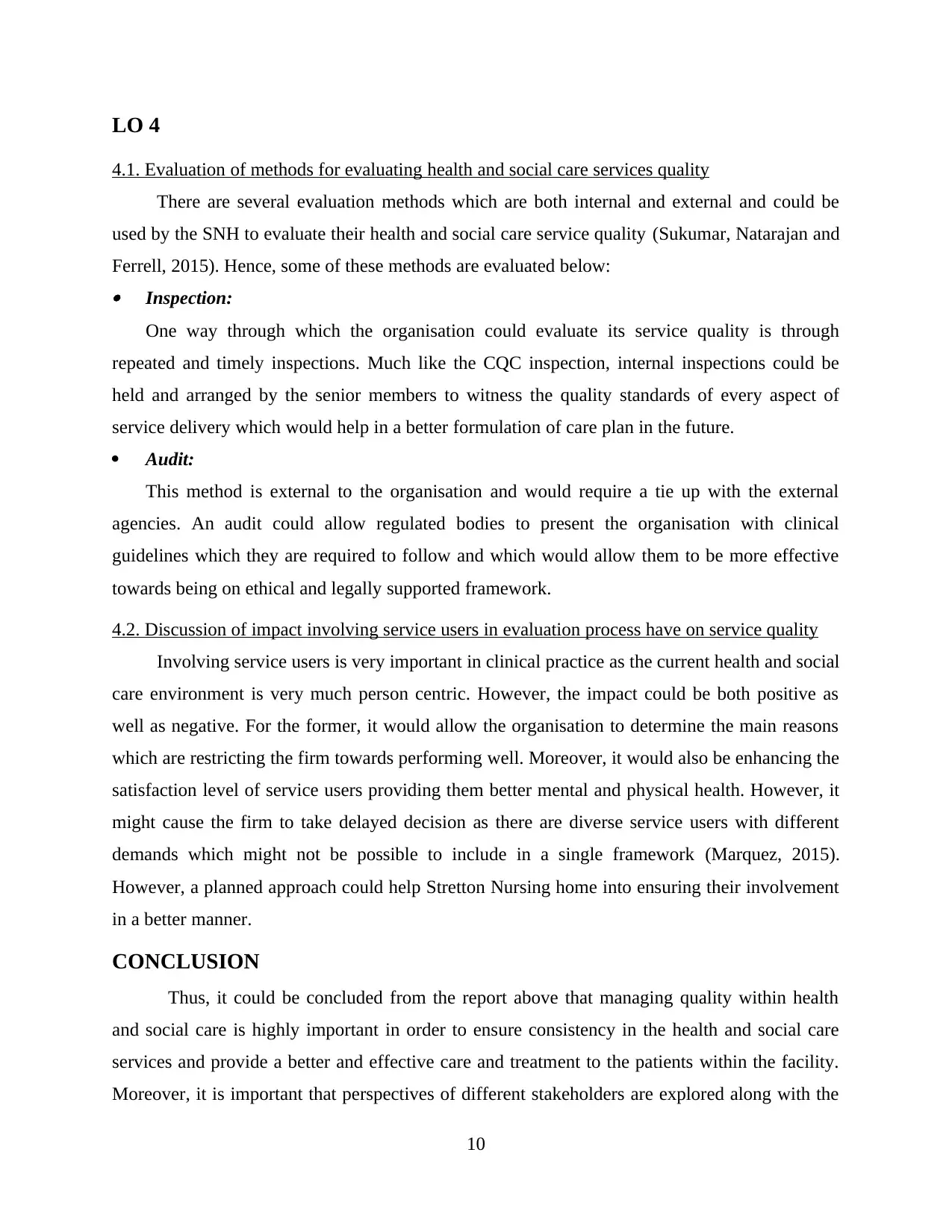
LO 4
4.1. Evaluation of methods for evaluating health and social care services quality
There are several evaluation methods which are both internal and external and could be
used by the SNH to evaluate their health and social care service quality (Sukumar, Natarajan and
Ferrell, 2015). Hence, some of these methods are evaluated below: Inspection:
One way through which the organisation could evaluate its service quality is through
repeated and timely inspections. Much like the CQC inspection, internal inspections could be
held and arranged by the senior members to witness the quality standards of every aspect of
service delivery which would help in a better formulation of care plan in the future.
Audit:
This method is external to the organisation and would require a tie up with the external
agencies. An audit could allow regulated bodies to present the organisation with clinical
guidelines which they are required to follow and which would allow them to be more effective
towards being on ethical and legally supported framework.
4.2. Discussion of impact involving service users in evaluation process have on service quality
Involving service users is very important in clinical practice as the current health and social
care environment is very much person centric. However, the impact could be both positive as
well as negative. For the former, it would allow the organisation to determine the main reasons
which are restricting the firm towards performing well. Moreover, it would also be enhancing the
satisfaction level of service users providing them better mental and physical health. However, it
might cause the firm to take delayed decision as there are diverse service users with different
demands which might not be possible to include in a single framework (Marquez, 2015).
However, a planned approach could help Stretton Nursing home into ensuring their involvement
in a better manner.
CONCLUSION
Thus, it could be concluded from the report above that managing quality within health
and social care is highly important in order to ensure consistency in the health and social care
services and provide a better and effective care and treatment to the patients within the facility.
Moreover, it is important that perspectives of different stakeholders are explored along with the
10
4.1. Evaluation of methods for evaluating health and social care services quality
There are several evaluation methods which are both internal and external and could be
used by the SNH to evaluate their health and social care service quality (Sukumar, Natarajan and
Ferrell, 2015). Hence, some of these methods are evaluated below: Inspection:
One way through which the organisation could evaluate its service quality is through
repeated and timely inspections. Much like the CQC inspection, internal inspections could be
held and arranged by the senior members to witness the quality standards of every aspect of
service delivery which would help in a better formulation of care plan in the future.
Audit:
This method is external to the organisation and would require a tie up with the external
agencies. An audit could allow regulated bodies to present the organisation with clinical
guidelines which they are required to follow and which would allow them to be more effective
towards being on ethical and legally supported framework.
4.2. Discussion of impact involving service users in evaluation process have on service quality
Involving service users is very important in clinical practice as the current health and social
care environment is very much person centric. However, the impact could be both positive as
well as negative. For the former, it would allow the organisation to determine the main reasons
which are restricting the firm towards performing well. Moreover, it would also be enhancing the
satisfaction level of service users providing them better mental and physical health. However, it
might cause the firm to take delayed decision as there are diverse service users with different
demands which might not be possible to include in a single framework (Marquez, 2015).
However, a planned approach could help Stretton Nursing home into ensuring their involvement
in a better manner.
CONCLUSION
Thus, it could be concluded from the report above that managing quality within health
and social care is highly important in order to ensure consistency in the health and social care
services and provide a better and effective care and treatment to the patients within the facility.
Moreover, it is important that perspectives of different stakeholders are explored along with the
10
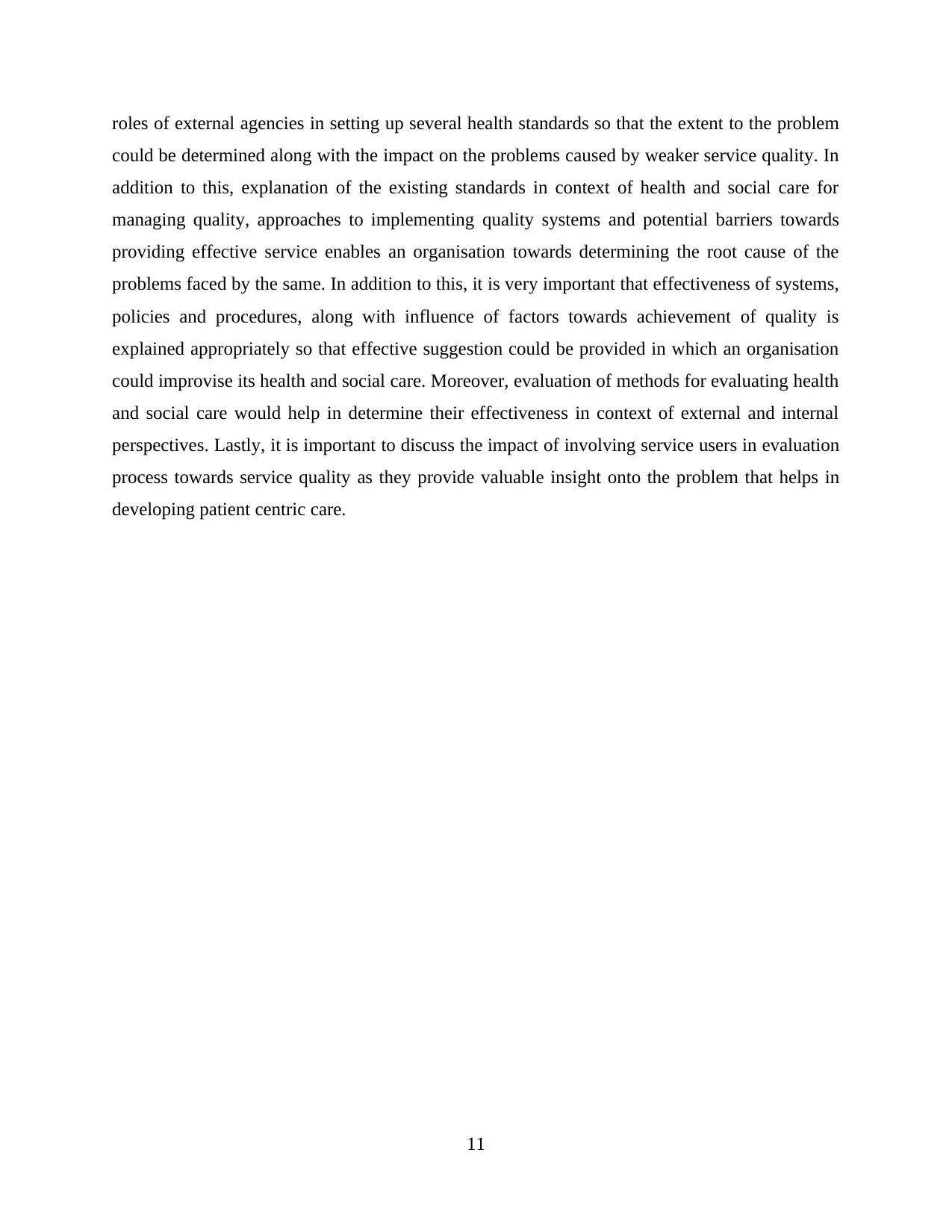
roles of external agencies in setting up several health standards so that the extent to the problem
could be determined along with the impact on the problems caused by weaker service quality. In
addition to this, explanation of the existing standards in context of health and social care for
managing quality, approaches to implementing quality systems and potential barriers towards
providing effective service enables an organisation towards determining the root cause of the
problems faced by the same. In addition to this, it is very important that effectiveness of systems,
policies and procedures, along with influence of factors towards achievement of quality is
explained appropriately so that effective suggestion could be provided in which an organisation
could improvise its health and social care. Moreover, evaluation of methods for evaluating health
and social care would help in determine their effectiveness in context of external and internal
perspectives. Lastly, it is important to discuss the impact of involving service users in evaluation
process towards service quality as they provide valuable insight onto the problem that helps in
developing patient centric care.
11
could be determined along with the impact on the problems caused by weaker service quality. In
addition to this, explanation of the existing standards in context of health and social care for
managing quality, approaches to implementing quality systems and potential barriers towards
providing effective service enables an organisation towards determining the root cause of the
problems faced by the same. In addition to this, it is very important that effectiveness of systems,
policies and procedures, along with influence of factors towards achievement of quality is
explained appropriately so that effective suggestion could be provided in which an organisation
could improvise its health and social care. Moreover, evaluation of methods for evaluating health
and social care would help in determine their effectiveness in context of external and internal
perspectives. Lastly, it is important to discuss the impact of involving service users in evaluation
process towards service quality as they provide valuable insight onto the problem that helps in
developing patient centric care.
11
Paraphrase This Document
Need a fresh take? Get an instant paraphrase of this document with our AI Paraphraser
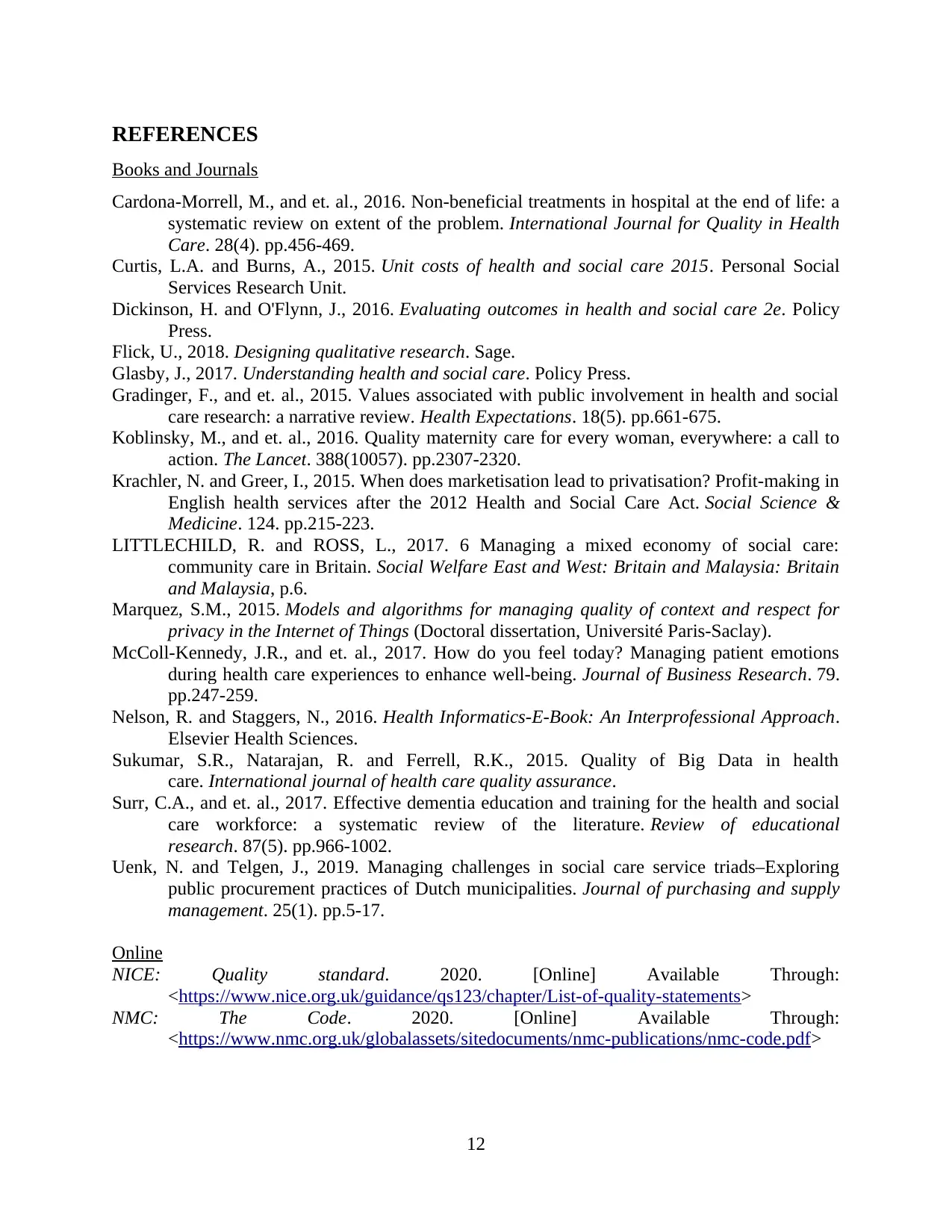
REFERENCES
Books and Journals
Cardona-Morrell, M., and et. al., 2016. Non-beneficial treatments in hospital at the end of life: a
systematic review on extent of the problem. International Journal for Quality in Health
Care. 28(4). pp.456-469.
Curtis, L.A. and Burns, A., 2015. Unit costs of health and social care 2015. Personal Social
Services Research Unit.
Dickinson, H. and O'Flynn, J., 2016. Evaluating outcomes in health and social care 2e. Policy
Press.
Flick, U., 2018. Designing qualitative research. Sage.
Glasby, J., 2017. Understanding health and social care. Policy Press.
Gradinger, F., and et. al., 2015. Values associated with public involvement in health and social
care research: a narrative review. Health Expectations. 18(5). pp.661-675.
Koblinsky, M., and et. al., 2016. Quality maternity care for every woman, everywhere: a call to
action. The Lancet. 388(10057). pp.2307-2320.
Krachler, N. and Greer, I., 2015. When does marketisation lead to privatisation? Profit-making in
English health services after the 2012 Health and Social Care Act. Social Science &
Medicine. 124. pp.215-223.
LITTLECHILD, R. and ROSS, L., 2017. 6 Managing a mixed economy of social care:
community care in Britain. Social Welfare East and West: Britain and Malaysia: Britain
and Malaysia, p.6.
Marquez, S.M., 2015. Models and algorithms for managing quality of context and respect for
privacy in the Internet of Things (Doctoral dissertation, Université Paris-Saclay).
McColl-Kennedy, J.R., and et. al., 2017. How do you feel today? Managing patient emotions
during health care experiences to enhance well-being. Journal of Business Research. 79.
pp.247-259.
Nelson, R. and Staggers, N., 2016. Health Informatics-E-Book: An Interprofessional Approach.
Elsevier Health Sciences.
Sukumar, S.R., Natarajan, R. and Ferrell, R.K., 2015. Quality of Big Data in health
care. International journal of health care quality assurance.
Surr, C.A., and et. al., 2017. Effective dementia education and training for the health and social
care workforce: a systematic review of the literature. Review of educational
research. 87(5). pp.966-1002.
Uenk, N. and Telgen, J., 2019. Managing challenges in social care service triads–Exploring
public procurement practices of Dutch municipalities. Journal of purchasing and supply
management. 25(1). pp.5-17.
Online
NICE: Quality standard. 2020. [Online] Available Through:
<https://www.nice.org.uk/guidance/qs123/chapter/List-of-quality-statements>
NMC: The Code. 2020. [Online] Available Through:
<https://www.nmc.org.uk/globalassets/sitedocuments/nmc-publications/nmc-code.pdf>
12
Books and Journals
Cardona-Morrell, M., and et. al., 2016. Non-beneficial treatments in hospital at the end of life: a
systematic review on extent of the problem. International Journal for Quality in Health
Care. 28(4). pp.456-469.
Curtis, L.A. and Burns, A., 2015. Unit costs of health and social care 2015. Personal Social
Services Research Unit.
Dickinson, H. and O'Flynn, J., 2016. Evaluating outcomes in health and social care 2e. Policy
Press.
Flick, U., 2018. Designing qualitative research. Sage.
Glasby, J., 2017. Understanding health and social care. Policy Press.
Gradinger, F., and et. al., 2015. Values associated with public involvement in health and social
care research: a narrative review. Health Expectations. 18(5). pp.661-675.
Koblinsky, M., and et. al., 2016. Quality maternity care for every woman, everywhere: a call to
action. The Lancet. 388(10057). pp.2307-2320.
Krachler, N. and Greer, I., 2015. When does marketisation lead to privatisation? Profit-making in
English health services after the 2012 Health and Social Care Act. Social Science &
Medicine. 124. pp.215-223.
LITTLECHILD, R. and ROSS, L., 2017. 6 Managing a mixed economy of social care:
community care in Britain. Social Welfare East and West: Britain and Malaysia: Britain
and Malaysia, p.6.
Marquez, S.M., 2015. Models and algorithms for managing quality of context and respect for
privacy in the Internet of Things (Doctoral dissertation, Université Paris-Saclay).
McColl-Kennedy, J.R., and et. al., 2017. How do you feel today? Managing patient emotions
during health care experiences to enhance well-being. Journal of Business Research. 79.
pp.247-259.
Nelson, R. and Staggers, N., 2016. Health Informatics-E-Book: An Interprofessional Approach.
Elsevier Health Sciences.
Sukumar, S.R., Natarajan, R. and Ferrell, R.K., 2015. Quality of Big Data in health
care. International journal of health care quality assurance.
Surr, C.A., and et. al., 2017. Effective dementia education and training for the health and social
care workforce: a systematic review of the literature. Review of educational
research. 87(5). pp.966-1002.
Uenk, N. and Telgen, J., 2019. Managing challenges in social care service triads–Exploring
public procurement practices of Dutch municipalities. Journal of purchasing and supply
management. 25(1). pp.5-17.
Online
NICE: Quality standard. 2020. [Online] Available Through:
<https://www.nice.org.uk/guidance/qs123/chapter/List-of-quality-statements>
NMC: The Code. 2020. [Online] Available Through:
<https://www.nmc.org.uk/globalassets/sitedocuments/nmc-publications/nmc-code.pdf>
12
1 out of 14
Related Documents
Your All-in-One AI-Powered Toolkit for Academic Success.
+13062052269
info@desklib.com
Available 24*7 on WhatsApp / Email
![[object Object]](/_next/static/media/star-bottom.7253800d.svg)
Unlock your academic potential
© 2024 | Zucol Services PVT LTD | All rights reserved.





